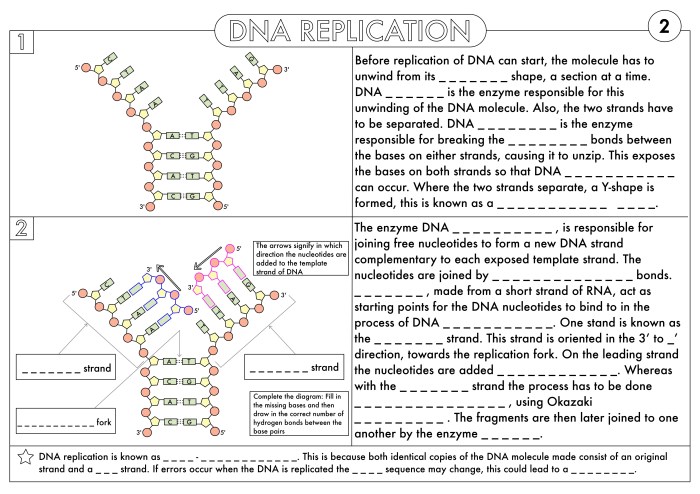Dna vs rna and protein synthesis updated answer key pdf – The DNA vs. RNA and Protein Synthesis Updated Answer Key PDF provides a comprehensive guide to the fundamental processes of molecular biology. This essential resource delves into the structural differences between DNA and RNA, explores the intricate mechanisms of transcription and translation, and highlights the critical role of genetic information in cellular function.
Understanding the relationship between DNA, RNA, and protein synthesis is paramount in unraveling the complexities of life. This answer key PDF empowers students, researchers, and professionals alike with a deeper understanding of these fundamental processes, equipping them with the knowledge to navigate the ever-evolving field of molecular biology.
DNA vs. RNA: Structure and Function

DNA and RNA are two essential molecules in cells that play vital roles in the storage and expression of genetic information. DNA, or deoxyribonucleic acid, is a double-stranded molecule that contains the genetic instructions for an organism. RNA, or ribonucleic acid, is a single-stranded molecule that is involved in protein synthesis and other cellular processes.DNA
and RNA have similar chemical compositions, but there are some key structural differences between the two molecules. DNA is composed of four different nucleotides: adenine, thymine, cytosine, and guanine. RNA also contains adenine, cytosine, and guanine, but instead of thymine, it contains uracil.
Additionally, DNA has a double-stranded structure, while RNA is single-stranded. The sugar-phosphate backbone of DNA is composed of deoxyribose, while the sugar-phosphate backbone of RNA is composed of ribose.
Functional Roles of DNA and RNA, Dna vs rna and protein synthesis updated answer key pdf
DNA is the primary genetic material in cells. It contains the instructions for building and maintaining an organism. DNA is located in the nucleus of cells, where it is packaged into chromosomes. When a cell divides, the DNA is copied so that each new cell has a complete set of genetic instructions.RNA
is involved in protein synthesis. It carries the genetic information from DNA to the ribosomes, where proteins are assembled. RNA is also involved in other cellular processes, such as regulating gene expression and catalyzing chemical reactions.
Transcription: DNA to RNA: Dna Vs Rna And Protein Synthesis Updated Answer Key Pdf

Transcription is the process of copying the genetic information from DNA into RNA. Transcription is carried out by an enzyme called RNA polymerase. RNA polymerase binds to the DNA template strand and uses it to create a complementary RNA molecule.
The RNA molecule is then released from the DNA template and travels to the ribosomes, where it is used to direct protein synthesis.
Post-transcriptional Modifications
After transcription, RNA molecules undergo a number of post-transcriptional modifications. These modifications include splicing, which removes introns (non-coding regions) from the RNA molecule, and capping and polyadenylation, which add protective groups to the ends of the RNA molecule. These modifications help to ensure that the RNA molecule is stable and can be efficiently translated into protein.
Translation: RNA to Protein
Translation is the process of converting the genetic information in RNA into a protein. Translation is carried out by ribosomes. Ribosomes bind to the RNA molecule and use it to direct the assembly of amino acids into a protein. The protein is then released from the ribosome and travels to its destination in the cell.
Genetic Code
The genetic code is a set of rules that determines how the sequence of nucleotides in RNA is translated into a sequence of amino acids in a protein. The genetic code is universal, meaning that it is the same in all organisms.
There are 64 different codons in the genetic code, each of which codes for a specific amino acid.
Post-translational Modifications
After translation, proteins undergo a number of post-translational modifications. These modifications include glycosylation, phosphorylation, and ubiquitination. These modifications can change the function, stability, and localization of the protein.
Comparison of DNA, RNA, and Protein Synthesis

DNA, RNA, and protein synthesis are three essential processes in cells. These processes work together to ensure that the genetic information in DNA is accurately copied and used to produce the proteins that the cell needs.DNA replication is the process of copying the genetic information from one DNA molecule to another.
Transcription is the process of copying the genetic information from DNA into RNA. Translation is the process of converting the genetic information in RNA into a protein.DNA replication, transcription, and translation are all complex processes that are essential for the life of a cell.
Errors in any of these processes can lead to genetic disorders.
General Inquiries
What are the key structural differences between DNA and RNA?
DNA is double-stranded and contains the sugar-phosphate backbone deoxyribose, while RNA is single-stranded and contains the sugar-phosphate backbone ribose.
How does transcription differ from translation?
Transcription converts DNA into RNA, while translation converts RNA into protein.
What is the role of the genetic code in protein synthesis?
The genetic code is a set of rules that determines the sequence of amino acids in a protein based on the sequence of nucleotides in RNA.